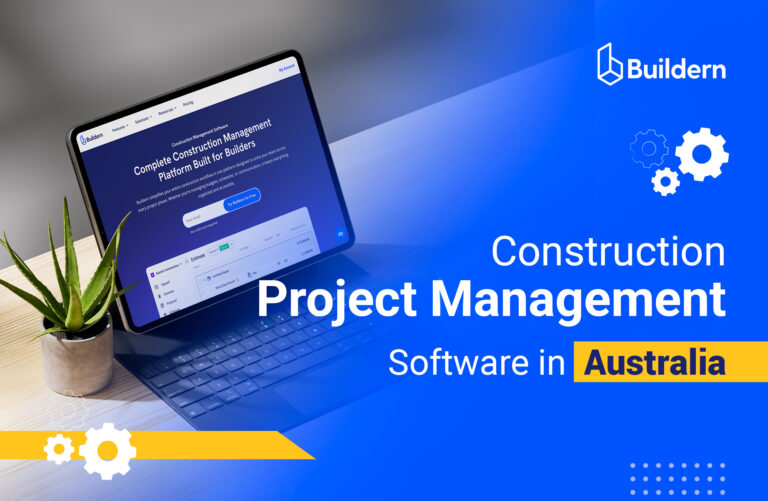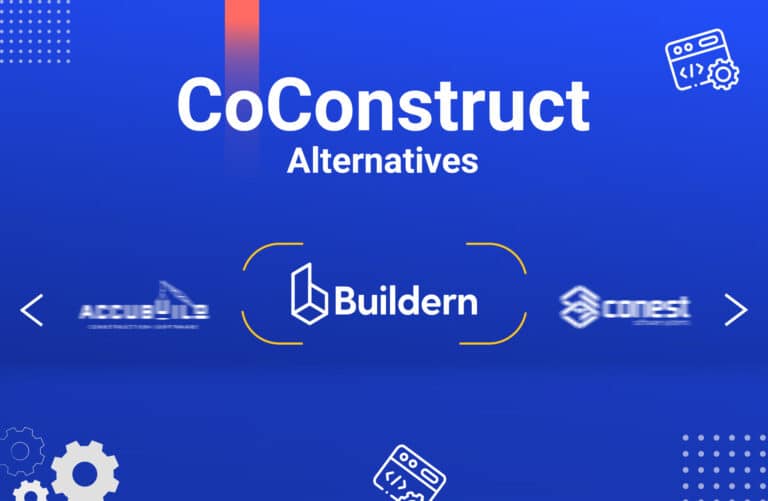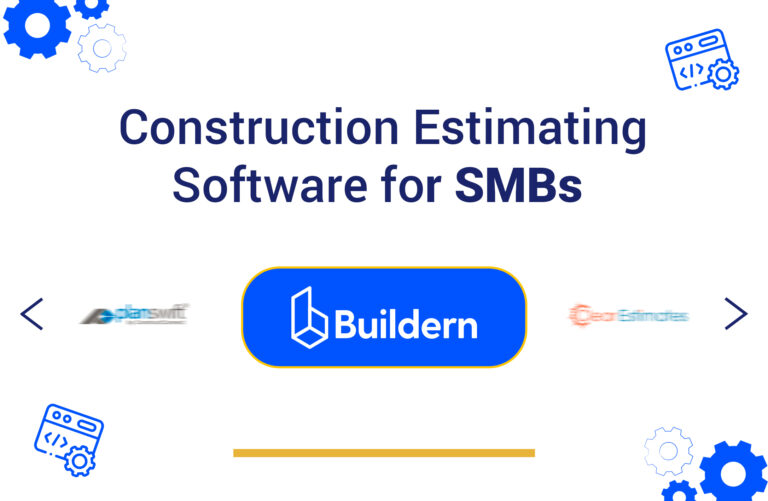Why Your Construction Sales Process Isn’t Working (And How to Fix It)

Sales breakdowns in construction aren’t always easy to spot. One client drifts away, and another job closes before the contract. Eventually, teams are chasing new leads while open estimates sit untouched.
These issues can significantly slow down revenue. Moreover, they can also affect scheduling and cash flow, block job starts, and create confusion across departments. Many of these losses aren’t due to pricing or reputation. They’re operational, resulting from a missed follow-up, slow response, or a proposal that lacked clarity or timing. Such cracks in the system turn opportunities into missed chances.
Our article maps out the pressure points in a typical construction sales process, offering builders practical ways to strengthen each step from the very basic internal workflows.
Table of Contents
- What a Construction Sales Process Should Look Like
- 5 Reasons Your Construction Sales Process May Not Work
- How to Fix a Broken Construction Sales Process
- Tools That Can Help Optimize the Process
- Quick Recap

What a Construction Sales Process Should Look Like
Effective sales systems in construction focus less on closing volume and more on consistency. They allow builders to guide qualified clients through a series of steps that reduce friction, support decision-making, and lead to jobs that move forward.
From the first time someone hears your name to the moment they sign (and refer you to others), each step of a successful construction sales funnel deserves intention.
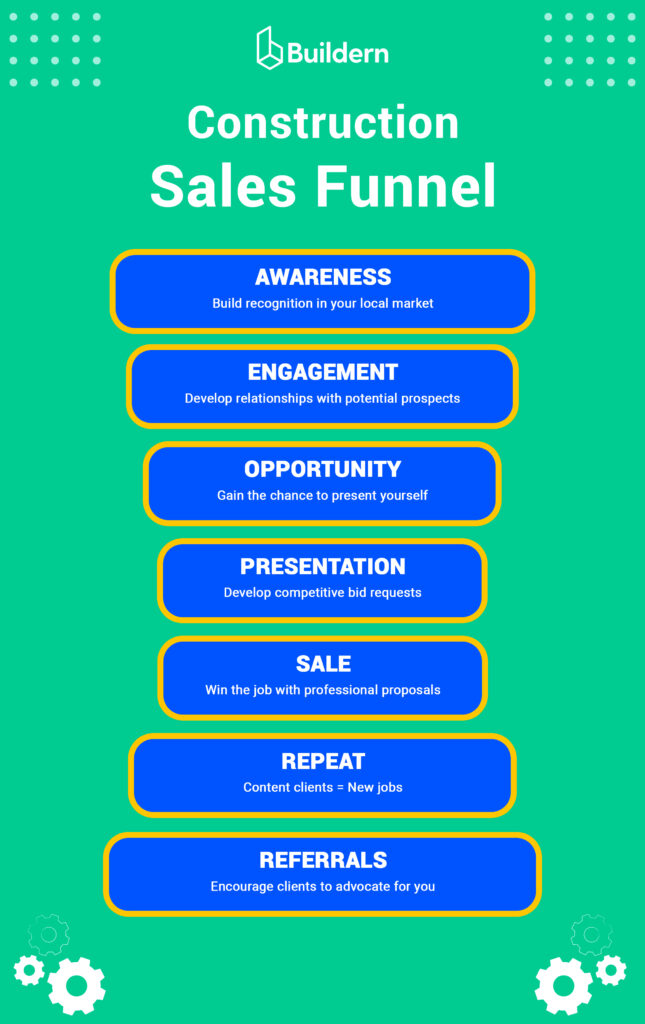
Below is a breakdown of a typical construction sales funnel. When executed well, it helps teams work smarter, avoid chasing dead-end leads, and create a steady pipeline of quality projects.
- Awareness: Build recognition in your local market through word-of-mouth, social media, job signs, and your website. This is where potential clients first encounter your company, so ensure it’s a solid first impression.
- Engagement: Start conversions by answering inquiries, attending community events, or replying to a web form. The end goal here is to build trust and gather key project details to prepare a proposal later.
- Opportunities: Once the job sounds like a fit, move toward a more detailed discussion. Qualify the lead based on location, timeline, and budget alignment. Filtering out mismatches here prevents wasted time later.
- Presentation: Submit a well-structured proposal. How you present your estimate matters just as much as the number itself. Clear scope, transparent pricing, and a professional format build confidence.
- Sale: Convert the opportunity into a signed job. Make it easy for clients to review and approve your proposal. Remember, delays often happen when they’re unclear on what’s next.
- Repeat: Satisfied clients are more likely to hire you again. Finish strong, stay responsive, and maintain your standards all the way through project closeout.
- Referrals: Encourage your satisfied clients to become your advocates. Create testimonials and make it easy for them to refer friends and develop a network for you.
What the ideal process does require is a strict and detailed structure, something teams can follow regardless of workload or job type. Without it, even good builders lose winnable work.
5 Reasons Your Construction Sales Process May Not Work
Many builders deliver excellent work on the job site but struggle to maintain consistency before the construction even starts. Sales processes in construction often break down not because of bad intentions, but because the tools and systems behind them weren’t built to handle the volume or complexity.
Here are five reasons those early-stage breakdowns happen and how to prevent them from costing real projects.
You’re Still Relying on Manual Tracking
When estimates live in folders, leads stay buried in inboxes, and follow-ups depend on sticky notes, things fall through. Even with a small team, it’s easy to lose track of who was contacted, what was promised, or when a client last heard from you. Manual tracking slows down the entire cycle, and once the construction sales process starts slipping, recovery may take time.
Missed replies and delayed updates can push good prospects away. In most firms, this isn’t a tech problem, but a visibility issue that can lead to lost jobs.
Estimates Take Too Long to Deliver
The longer it takes to send the quote, the less likely the client is to sign it. Leads go cold fast, especially when they’re collecting bids from multiple builders. The delay can be caused by waiting on subcontractor numbers, unclear scope definitions, or jumping between disconnected tools.
As a result, if your estimate feels late or incomplete, clients may start questioning what the rest of the process will look like and choose a builder who shows the most professionalism.
Your Team Lacks Sales Training
Most builders don’t hire salespeople and prefer to promote someone from within. Project managers, estimators, or office admins end up handling leads. And while they may know the job inside out, few have been trained to guide clients through the decision-making process.
Without consistent messaging, clear talking points, or a way to handle common objections, clients leave meetings with more questions than answers. Technical knowledge matters, but only when paired with confidence and professional sales skills, it may translate into a signed contract.
Poor Handoff Between Sales and Production
Once the contract is signed, there’s often a gap. The person who handled the initial discussions and presented the final proposal steps out, and the production team steps in (often with little context).
Some of the pre-discussed aspects may be lost in the process if not documented properly. As a result, some of the client preferences may get ignored, resulting in internal questions multiplying and leaving gaps in the workflows.
No Clear Follow-Up Process
Strong leads don’t always disappear because of pricing or timing. In many cases, the estimate was solid, the conversation went well, and then nothing happened. No second call, no reminder, no next step.
It’s always a strategy problem and a structure one. Builders often intend to follow up, and the lack of a shared system turns follow-through into assumptions. CRM tools or even the simplest task boards can prevent good prospects from falling off the radar.
How to Fix a Broken Construction Sales Process
Fixing the process begins with visibility and ends with internal systems that reduce guesswork at every step. Having a structure with repeatable steps and tools to fit in with how your construction business operates will help you create a smoother, repeatable workflow that supports both clients and teams.
Below are the foundational fixes every construction business can implement, regardless of company size or project type:
#1 Map Your Existing Workflow
Without a clear picture of how leads move through the pipeline, it becomes difficult to see at what point delays may occur. Every business handles intake slightly differently, but documenting that path from first inquiry to final handoff reveals where clients lose momentum.
💡Start by outlining the process visually.
Flowcharts, boards, or column-based trackers make movement easy to follow. Teams using construction project management software with built-in CRM capabilities map out stages, assign ownership, and maintain momentum across touchpoints.
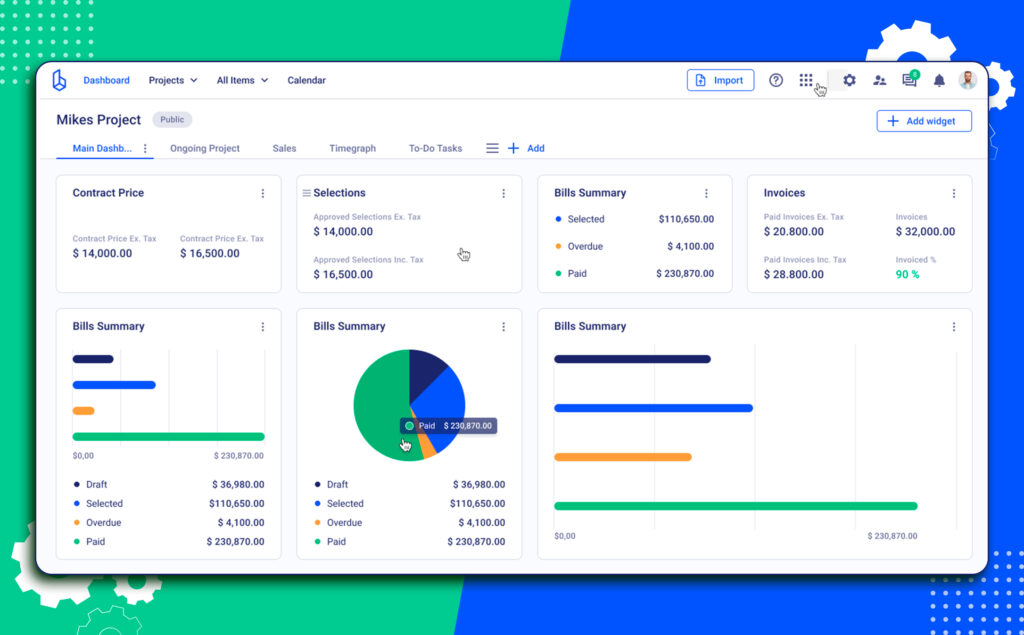
#2 Speed Up Estimating
Delays in pricing often come from scattered tools and missing details. Switching between takeoff files, spreadsheets, and emails slows the process down and increases the risk of error.
With a connected workflow, estimators can pull from predefined templates or past jobs to generate faster, more accurate numbers. When scopes, materials, and cost codes are linked in one system, the time between inquiry and proposal gets noticeably shorter, and trust builds faster.
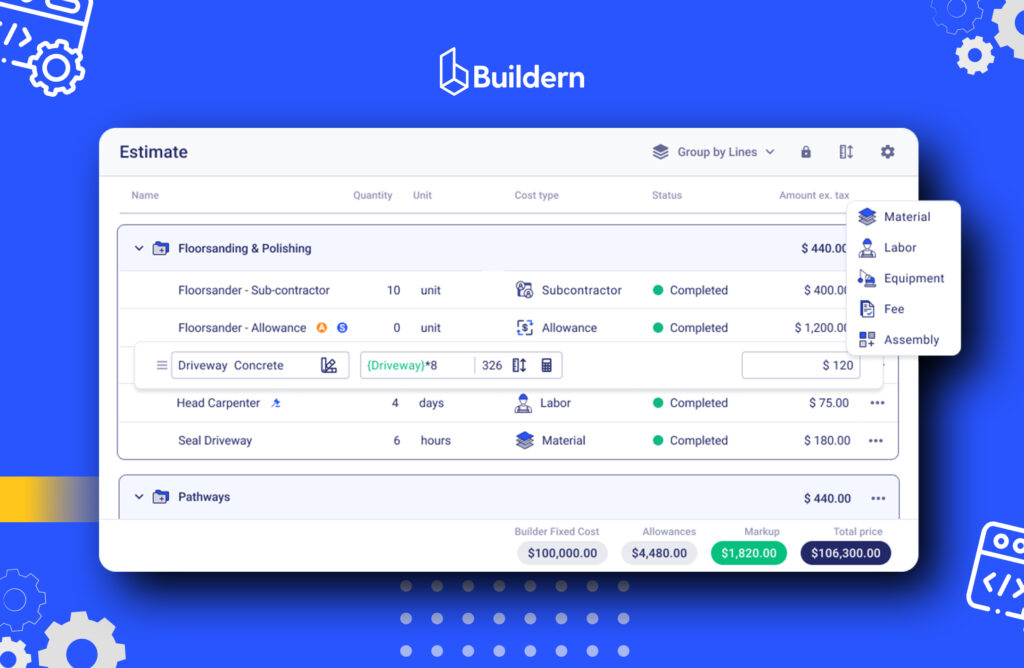
#3 Standardize Communication and Touchpoints
Clients begin to feel uncertain when teams communicate using different formats and communication channels. One email might come from a Gmail account, the next message might arrive via text, and the proposal could be a Word doc with inconsistent formatting. This kind of inconsistency chips away at trust, especially in the early stages of a client relationship.
💡Fix this by creating a standardized process for both what you say and how you deliver it.
Build a core library of templates for emails, follow-ups, and proposals. When your messaging sounds professional and arrives on time, it sets the tone for the whole project. However, consistency isn’t only about the text, but also about the experience.
You don’t have to build a communication system from scratch if you use corresponding tools with built-in capabilities for all of these. What’s left for you is providing realistic numbers and creating a smooth experience for potential clients. That also allows you to include everything upfront, such as project scope, legal terms, timelines, and specifications.
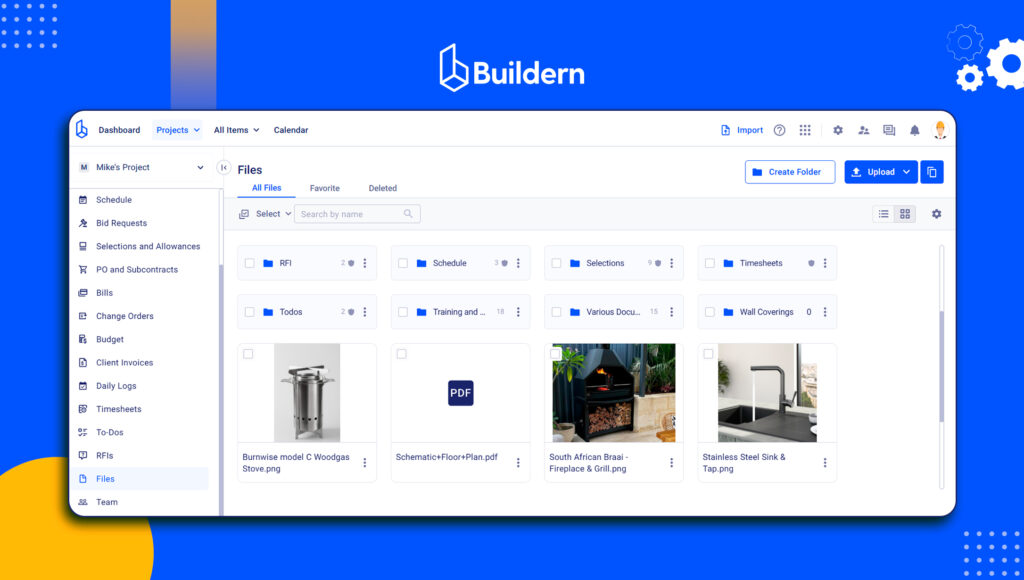
4. Align Sales with Operations Early
Miscommunication between the sales and production teams creates unnecessary friction. Information can easily get lost, bringing in unsupported assumptions and clients feeling disconnected from the flow.
💡Instead of treating the project kickoff as a reset point, use it as a bridge.
Create a checklist for internal handoff: final scope, signed documents, selection choices, and client concerns. This keeps everyone informed, aligned, and able to begin construction with fewer surprises.
5. Track KPIs for Sales
Without clear benchmarks, even a structured sales process can fall short. Many builders focus on how many proposals go out, but not on how efficiently those proposals move through the pipeline. Tracking a few specific metrics can surface patterns that explain why certain leads convert while others fade.
Here are a few essential KPIs to monitor regularly:
- Lead response time: A fast initial reply often sets the tone for the entire client relationship. Builders who respond within a few hours, not days, tend to hold attention longer and compete better.
- Time-to-quote: This tracks the duration from initial scoping to final proposal delivery. When quoting takes too long, clients often move on, even if the numbers were accurate. Delays may stem from tool handoffs, scattered inputs, or waiting on subcontractor pricing.
- Win rate: Out of all the proposals submitted, how many turn into jobs? A consistent drop in the win rate might indicate misaligned pricing, unclear scope, or a proposal format that doesn’t match client expectations.
- Drop-off stage: Mapping where prospects disengage helps spot weak points in the process. Do leads stop replying after the walkthrough or contract review? Each stage suggests a different type of issue and solutions to it.
Once these numbers are consistently tracked, decisions become less reactive. Teams begin to understand what’s slowing them down, which parts require attention, and which changes bring results. Even modest improvements in quoting speed or follow-up rates can lead to more signed contracts.
Tools That Can Help Optimize the Process
Building a better sales pipeline often means tightening the way information moves. Most breakdowns happen not because of skill gaps, but because systems don’t support handoffs, status updates, or team visibility. The right construction software can make a difference here.
Tools built specifically for construction teams help connect estimates, scheduling, and stakeholder interaction. They minimize duplication, reduce error rates, and ensure that critical details move forward cleanly as each job advances.
Beyond organizing data, they create accountability. Everyone knows who owns which step and where the lead currently stands. This becomes even more important as project volume grows or multiple team members start managing incoming jobs.
What to Look for in a Construction Sales Tool
CRM Designed for Construction
Most general CRMs were built for industries with fixed products or monthly contracts, not for complex, high-touch projects. A construction-specific CRM organizes leads by job type, location, value, and phase. This helps prioritize outreach and maintain clarity across dozens of open conversations without losing sight of any.
Estimating and Proposal Generation
The more time estimators spend formatting documents, the less time they spend improving accuracy. Proposal tools that tie directly into estimate templates, material databases, and scope checklists remove bottlenecks. Clients receive faster, clearer pricing and teams avoid last-minute edits.
Mobile-Friendly Access for Field Consultations
Whether it’s a quick client question at the site or a pricing update during a meeting, mobile access keeps momentum going. Teams that can open proposals, make edits, or access scope notes in real time have more productive conversations, especially when in front of the client.
Integration with Scheduling and Invoicing
Once a job moves past the sales stage, the details should carry forward automatically. Proposals, client notes, and scope definitions need to integrate with production, billing, and calendar systems. When that connection is missing, tasks get repeated and miscommunication increases. The right platform helps keep everything synchronized from sales call to project handover.
Quick Recap
Solid construction sales processes cannot be built overnight, but you can improve yours step by step with the right approach. From capturing and qualifying leads to sending timely, professional proposals, every part of the sales journey benefits from clear systems and better coordination.
Identify the gaps in your current process and start building a funnel with the right tools and habits in place.
The sooner you tighten your sales process, the sooner you’ll stop losing leads and start closing more jobs with confidence.

What Are the 7 Stages of the Construction Sales Funnel?
The key 7 stages of a successful construction sales funnel include:
- Awareness: Building visibility through local presence, ads, or referrals.
- Engagement: Starting conversations with interested prospects.
- Opportunity: Qualifying leads based on fit, scope, and budget.
- Presentation: Submitting a clear, professional proposal.
- Sale: Getting approval and signing the contract.
- Repeat: Earning additional work from satisfied clients.
- Referrals: Turning happy clients into brand advocates.
How Fast Should Builders Respond to a New Inquiry?
Most clients expect to hear back within a business day. Anything longer gives the impression that the builder may be overbooked or disorganized. Even a short message confirming receipt can keep the conversation moving.
What’s the Role of Construction CRM in Building Construction Sales Processes?
Construction-specific CRM software helps builders organize, track, and manage every lead from first contact to signed contract. You may centralize the communication by setting follow-up reminders, creating a separate client portal for each client, and keeping all the project-related data in a single place.
